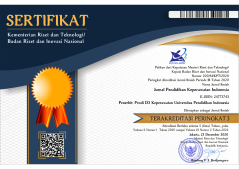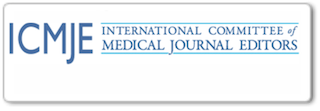Peer Relationship Analysis and the Quality of Life at School in Early Adolescents
Abstract
The suboptimal state of quality of life will have an impact on the physical health and psychological welfare of individuals. When early adolescents are excluded from their age group, their quality of life is compromised. The primary objective of this research is to examine the correlation between peer relationships and the quality of life at school experienced by early adolescents. The methodology employed in this study involved the utilization of a cross-sectional approach. The independent variables in this research encompass the following respondent characteristics: age, gender; peer relationships; and quality of life at school. The population under investigation consisted of 569 early adolescents in one of a state junior high school in South Jakarta. Total sampling was employed as the sampling technique for this study. The research instrument utilized was a modified questionnaire derived from The Peer Relationship Scale and The Quality of Life in School Questionnaire, which underwent rigorous testing to ensure its validity and reliability. In conducting bivariate analysis, the chi-square test was employed. The findings of this research indicate that a majority of the adolescents surveyed exhibited poor peer relationships, with 312 respondents (54.8%) falling into this category. Furthermore, a significant proportion of the respondents reported a low quality of life at school, with 378 adolescents (66.4%) falling into this category. In addition, the majority of the sub-dimensions of quality of life in school, namely psychosocial well-being, attitudes towards school, student-teacher relationships, and the school environment, were reported as being poor (64.1%, 80.3%, 64.7%, and 56.4%, respectively). The quality of relationships between peers impacts adolescents' quality of life at school (p value = <0.000; α < 0.05). Positive peer relationships have the potential to enhance the emotional and psychological well-being of adolescents, whereas extended conflict can engender the contrary effect.
Keywords
Full Text:
PDFReferences
Afiyanti, Y. (2010). Quality of Life Analysis. Indonesian Nursing Journal, 13 (2), 81–86.
Alsarrani, A., Hunter, R.F., Dunne, L., & Garcia, L. (2022). Association between friendship quality and subjective well-being among adolescents: a systematic review. BMC Public Health, 22 (1), 1–37.
An, S.-J., Lee, H.-C., & Lim, J.-Y. (2013). The Influences of Conflict with Parents, Peer Relationships, and School Adaptation of Adolescents from Multicultural Families and Their Satisfaction with Life: The Mediating Effects of Self-Esteem. Journal of Korean Home Management Association, 31 (2), 77–91.
Aydogdu, F. (2022). Developing a Peer Relationship Scale for Adolescents: a validity and reliability study. Current Issues in Personality Psychology, 10 (2), 164–176.
Backes, E., & Bonnie, R. (2019). The Promise of Adolescence: Realizing Opportunity for All Youth. Washington (D.C.): National Academies Press. 1-10.
Berkman, JHPT (2018). The Development of Self and Identity in Adolescence: Neural Evidence and Implications for a Value-Based Choice Perspective on Motivated Behavior. Child Dev Perspect. , 12 (3), 158–164.
Branje, S., de Moor, E.L., Spitzer, J., & Becht, A.I. (2021). Dynamics of Identity Development in Adolescence: A Decade in Review. Journal of Research on Adolescence, 31 (4), 908–927.
Bult, MK, Van Bindsbergen, KLA, Schepers, SA, De Ridder-Sluiter, HG, Verhaak, CM, Van Litsenburg, RRL, … Grootenhuis, MA (2019). Health-related quality of life of adolescents with cancer during the first year of treatment. Journal of Adolescent and Young Adult Oncology, 8 (5), 616–622.
Buttitta, M., Iliescu, C., Rousseau, A., & Guerrien, A. (2014). Quality of life in overweight and obese children and adolescents: a literature review. Quality of life research: An international journal of quality of life aspects of treatment, care, and rehabilitation, 23 (4), 1117–1139.
Dewey, D., & Volkovinskaia, A. (2018). Health-related quality of life and peer relationships in adolescents with developmental coordination disorder and attention-deficit–hyperactivity disorder. Developmental Medicine and Child Neurology, 60 (7), 711–717.
Farooq, S.A., Muneeb, A., Ajmal, W., Tauni, M.A., Mahmood, S., Sohaib Qadri, S.K., … Rizvi, N. (2017). Quality of Life Perceptions in School-Going Adolescents with Social Anxiety. Journal of Childhood & Developmental Disorders, 03 (02), 1–5.
Felix, J., Stark, R., Teuner, C., Leidl, R., Lennerz, B., Brandt, S., … Holle, R. (2020). Health-related quality of life associated with extreme obesity in adolescents - Results from the baseline evaluation of the YES-study. Health and Quality of Life Outcomes, 18 (1), 1–11.
Fu, J., Cheng, Z., Liu, S., Hu, Z., Zhong, Z., & Luo, Y. (2021). Development and validation of peer relationship scale for Chinese community-dwelling elderly. Psychology Research and Behavior Management, pp. 14, 889–903.
Kaal, SEJ, Lidington, E.K., Prins, J.B., Jansen, R., Manten-Horst, E., Servaes, P., … Husson, O. (2021). Health-related quality of life issues in adolescents and young adults with cancer: Discrepancies with the perceptions of health care professionals. Journal of Clinical Medicine, 10 (9), 1–15.
Kousha, M., & Kakrodi, M. A. (2019). Can parents improve the quality of life of their children with attention deficit hyperactivity disorder? Iranian Journal of Psychiatry, 14 (2), 154–159.
Lezhnieva, N., Fredriksen, P. M., & Bekkhus, M. (2018). Peer relationships and quality of life in 11–12-year-old children: The Health Oriented Pedagogical Project (HOPP). Scandinavian Journal of Public Health, 46 (21_suppl), 74–81.
Lima-Serrano, M., Lemos, I., & Nunes, C. (2013). Adolescent quality of life and health behaviors: a comparative study between adolescents from the south of Portugal and Spain TT - Qualidade de vida e comportamentos de saúde: um estudo comparativo entre adolescents do sul de Portugal e da Espanha T.T. -. Texto & contexto enferm , 22 (4), 893–900.
Loeb, E.L., Kansky, J., Tan, J.S., Costello, M.A., & Allen, J.P. (2021). Perceived Psychological Control in Early Adolescence Predicts Lower Levels of Adaptation into Mid-Adulthood. Child Dev, 92 (2), e158–e172.
Magiera, A., & Pac, A. (2022). Determinants of Quality of Life among Adolescents in the Małopolska Region, Poland. International Journal of Environmental Research and Public Health, 19 (14).
Mastorci, F., Bastiani, L., Doveri, C., Trivellini, G., Casu, A., Vassalle, C., & Pingitore, A. (2020). Adolescent Health: A Framework for Developing an Innovative Personalized Well-Being Index. Frontiers in Pediatrics, 8 (May), 1–8.
Mikkelsen, H.T., Småstuen, M.C., Haraldstad, K., Helseth, S., Skarstein, S., & Rohde, G. (2022). Changes in health-related quality of life in adolescents and the impact of gender and selected variables: a two-year longitudinal study. Health and Quality of Life Outcomes, 20 (1), 1–11.
Mitic, M., Woodcock, K.A., Amering, M., Krammer, I., Stiehl, K.A.M., Zehetmayer, S., & Schrank, B. (2021). Toward an Integrated Model of Supportive Peer Relationships in Early Adolescence: A Systematic Review and Exploratory Meta-Analysis. Frontiers in Psychology, 12 (February), 1–28.
Phyo A, Freak-Poli R, Craig H, Gasevic D, Stocks N, Gonzalez-Chica D, & Ryan J. (2020). Quality of life and mortality in the general population: a systematic review and meta-analysis. BMC Public Health, (20), 1596.
Ravens-Sieberer, U., Karow, A., Barthel, D., & Klasen, F. (2014). How to assess quality of life in child and adolescent psychiatry. Dialogues in Clinical Neuroscience, 16 (2), 147–158.
Robinson, S., Kissane, D. W., Brooker, J., Hempton, C., & Burney, S. (2017). The Relationship Between Poor Quality of Life and Desire to Have Death: A Multiple Mediation Model Examining the Contributions of Depression, Demoralization, Loss of Control, and Low Self-worth. Journal of Pain and Symptom Management, 53 (2), 243–249.
Salgado, M., González, L., & Yáñez, A. (2021). Parental Involvement and Life Satisfaction in Early Adolescence. Frontiers in Psychology, 12 (February), 1–12.
Solera-Sanchez, A., Adelantado-Renau, M., Moliner-Urdiales, D., & Beltran-Valls, M.R. (2021). Health-related quality of life in adolescents: individual and combined impact of health-related behaviors (DADOS study). Quality of Life Research, 30 (4), 1093–1101.
Steinmayr, R., Wirthwein, L., Modler, L., & Barry, M. M. (2019). Development of subjective well-being in adolescence. International Journal of Environmental Research and Public Health, 16 (19).
Sussman, S., Pokhrel, P., Ashmore, R.D., & Brown, B.B. (2007). Adolescent peer group identification and characteristics: A review of the literature. Addictive Behaviors, 32 (8), 1602–1627.
Van den Akker, AL, Briley, DA, Grotzinger, AD, Tackett, JL, Tucker-Drob, EM, & Harden, KP (2021). Adolescent Big Five personality and pubertal development: Pubertal hormone concentrations and self-reported pubertal status. Developmental Psychology, 57 (1), 60–72.
Vania, I., Yudiana, W., & Susanto, H. (2022). Does Online-Formed Peer Relationship Affect Academic Motivation During Online Learning? Journal of Educational, Health and Community Psychology, 11 (1), 72.
World Health Organization. (2012). Program on mental health: WHOQOL user manual.
World Health Organization. (2022). Adolescent health.
DOI: https://doi.org/10.17509/jpki.v9i2.62792
Refbacks
- There are currently no refbacks.
Jurnal Pendidikan Keperawatan Indonesia(JPKI) published by Indonesia University of Education. JPKI is licensed under a Creative Commons Attribution-ShareAlike 4.0 International License.
Office :
Nursing Department. FPOK UPI.
229, Dr. Setiabudhi Street. Bandung 40154
West Java , Indonesia
E-mail : jpki@upi.edu

_.png)
_.png)
_.png)











